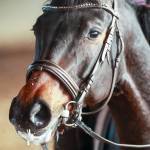Measuring Salivary Insulin Desirable But Not Yet Feasible

High circulating levels of insulin and adiponectin are known predictors of a specific form of laminitis called endocrinopathic (hyperinsulinemia-associated) laminitis. This is currently the most common form of laminitis that is untreatable in many horses and ponies, prompting euthanasia. Measuring blood insulin levels is a frequent occurrence when managing this type of laminitis as maintaining low insulin levels through nutrition and medication will improve the patient’s chance of survival.
“In other species, such as humans and dogs, insulin can be measured in saliva samples collected from the patient instead of blood samples. Measuring salivary insulin eases the burden of sampling and improves patient comfort,” explained Ashley Fowler, Ph.D., a Kentucky Equine Research nutritionist.
Having a saliva test rather than a blood test would be beneficial as frequent sampling in horses at risk of or currently affected with endocrinopathic laminitis is recommended. Saliva samples could be collected by owners and shipped to a laboratory for analysis rather than requiring a veterinarian to visit the farm to collect a blood sample during an oral sugar test, for example.
Unfortunately, salivary insulin and adiponectin levels in horses do not accurately reflect circulating levels of those hormones in the bloodstream. To investigate the efficacy of using these salivary predictors in horses, researchers measured insulin and adiponectin in paired saliva and blood samples from eight healthy ponies over two weeks. *
“Unlike the case in other species, adiponectin was not measurable in equine saliva samples. Insulin could be measured in saliva, but those levels did not match blood levels of insulin collected at the same time as the saliva samples,” Fowler said.
Given the high incidence of endocrinopathic laminitis and the pain and debilitation associated with this condition, specific guidelines have been developed for horses and ponies to lower their circulating insulin levels. According to Fowler, some of those recommendations include the following:
- Feeding a diet low in nonstructural carbohydrates (NSCs), including appropriate hay or forage alternative;
- Restricting or eliminating pasture access to keep horses from consuming NSCs found in grass, paying special attention to season and environmental conditions;
- Encouraging weight loss in overweight horses by restricting caloric intake; and
- Adding an exercise program, which is known to help improve insulin levels, even in nonobese horses.
“Finally, adding a ration balancer or vitamin-mineral supplement ensures the horse’s requirements are met so their body and metabolism can function optimally,” added Fowler.
*Barnabé, M.A., J. Elliott, P.A. Harris, and N.J. Menzies-Gow. 2023. Insulin, but not adiponectin, is detectable in equine saliva using an automated, commercial assay. Equine Veterinary Journal. doi:10.1111/evj.14019.








